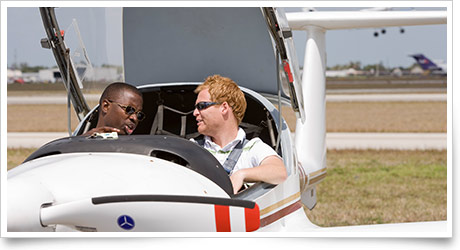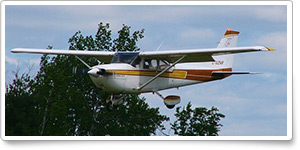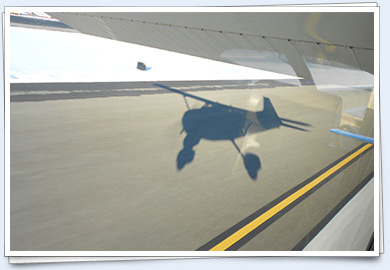|
|||||
Training TipsShowing what you've got
What if you don't? The effort to explain a concept or task can unmask the reason for your error and help eliminate it. That's why some occasional role reversal is valuable during flight training.
At various times during training, opportunities come along for you to gauge your knowledge by explaining the reasoning behind the techniques you demonstrate in flight. That's good rehearsal for your practical test, when your ability to exhibit knowledge comes in for verbal and observational examination.
The three hours of test prep mandated for private pilot trainees by 14 CFR 61.109 carve out an official niche for parsing procedures and principles. But it need not be the first time you "teach" terms, tasks, and techniques.
Post-training-flight debriefings are a good chance to focus on this skill. Reviewing a turn around a point flown in a 10-knot wind, you note that you steepened the bank angle to maximum as you reached the downwind heading. Why did the steeper bank angle keep the maneuver within standards? It increased the rate of turn, enabling you to maintain the proper distance from the ground reference as the groundspeed increased. (Sketch an illustration.)
At the completion of a steep turn, you reduced pitch during the rollout to avoid climbing. Why was this necessary? ("The steep turn's horizontal component of lift requires the aircraft to be flown at a higher angle of attack than is needed in straight-and-level flight.")
Don't overlook discussing any unexpected scenarios encountered during the lesson, explaining the thinking that went into your decisions about how to react in those high-value teachable moments.
Riding as a rear-seater on another student's dual lesson is a great chance to watch the learning process unfold; think of it as a free lesson experienced from a new vantage point.
Some Q-and-A during a phase check, or when flying with a stand-in for your regular CFI, can sharpen your focus on elements of technique.
One possible outcome of assuming the teacher's role is that you may uncover the need to hit the books again on a subject or two.
Another possible outcome: You may find that you're a pretty good teacher! Flight Training NewsPilot rates milestone birthday a successTwo grueling flight tests and a mountain of paperwork aren't what most people imagine when it comes to a fun way to celebrate a birthday. But most people aren't pilots. Those who are will understand why Drew Gryder got up on the morning of Oct. 14—his seventeenth birthday—and headed for the airport to take his private pilot flight test on the first day of his eligibility for the certificate. He didn't stop there. Read more >> Need help making a go/no go decision?The benefit of hindsight is that while looking back, we're always right. But we don't have that luxury before making any decision. With that in mind, the Air Safety Institute's Flight Risk Evaluator mobile app helps pilots make that crucial go/no-go decision while safely on the ground. The app takes into account many of the variables we weigh before flying and provides an objective look at how risky any flight may be before we even crank the engine. Learn more >> Students participate in space campFive students and one teacher from Walter R. Sundling Junior High in Palatine, Ill., took part in the ultimate space adventure in the summer with help from the Northrop Grumman Foundation. The students and teacher received a sponsorship from the foundation to attend Space Camp at the U.S. Space and Rocket Center in Huntsville, Ala. Student campers participated in activities such as rocket building and launching, experiencing weightlessness in an astronaut-training simulator, and simulating space travel preparation. The teachers attended the Space Academy for Educators, a program designed to provide them with the tools to enhance how they use science, technology, engineering, and mathematics (STEM) concepts in the classrooms. Developers offer training apps for pilots, mechanicsStudent pilots and aviation professionals may want to try these five training apps: King Air 200, Prepware Aviation Maintenance Technician, US Aviation Academy, King Schools Companion App, and Instrument Pilot Checkride. Read more >> 'Tis the seasonHeading home for the holidays? It's a great reason to fly! As on any flight, a keen awareness of the types of airspace ahead is a must. Learn more about the considerations needed to fly in modern airspace safely and smartly. Take the Air Safety Institute's Know Before You Go: Navigating Today's Airspace online course. Log in to take the course >> Training ResourcesDatalink weather radarWeather radar is the most commonly used datalink weather product and although it seems simple, there are a few things you should know about datalink radar to use it well. Take this quiz to get up to speed. Log in to take the quiz >>
Did you know that student pilots who join AOPA are three times more likely to complete their flight training? Membership includes unlimited access to aviation information by phone (800/USA-AOPA, weekdays from 8:30 a.m. to 8 p.m. Eastern time) or from Flight Training Online or AOPA Online. If you're not already a member, join today and get the pilot's edge.
Falcon 5X, hot props from HartzellOn the scene at the National Business Aviation Association's annual convention in Las Vegas, AOPA Live This Week® interviews Falcon Chief Test Pilot Philippe Deleume about the Falcon 5X flight control system and handling. Also, Iron Maiden's Bruce Dickinson discusses the Eclipse 550, and Hartzell's Joe Brown talks about the sophisticated composite props the company is producing, including one for the TBM 700/850. AOPA Live This Week, Oct. 24. Career PilotUnited adds routes from West Coast hubsUnited Airlines will begin new nonstop service from its two West Coast hubs on April 1, 2014, with twice-daily flights between San Francisco and Atlanta and between Los Angeles and Minneapolis. United will operate the Atlanta flights using Boeing 737-800 aircraft, and SkyWest Airlines will operate the United Express service to Minneapolis using Bombardier CRJ700 regional jets. Also on April 1, United will add a new flight between San Francisco and Seattle, and will convert all of its existing service on the route to mainline aircraft. JetBlue announces flights to Savannah, WorcesterJetBlue Airways announced Oct. 7 that it will begin nonstop service between its Boston hub and Savannah, Ga., on Feb. 13, 2014. Savannah will be the carrier's fiftieth nonstop destination from Boston. JetBlue will operate one round-trip flight each day using a 100-seat Embraer E190. The airline also said that it will start service to Massachusetts' Worcester Regional Airport on Nov. 7.
For more aviation career news, see the Flight Training website. Plane SpotterHeavier than a 'hawk
Training ProductsFAA updates glider handbookThe Glider Flying Handbook is designed as a technical manual for applicants who are preparing for a glider category rating and for currently certificated glider pilots who wish to improve their knowledge. The handbook offers detailed coverage of aeronautical decision making, components and systems, aerodynamics, flight instruments, performance limitations, ground operations, flight maneuvers, traffic patterns, emergencies, soaring weather, soaring techniques, and cross-country flight.
Note: Products listed have not been evaluated by ePilot editors unless otherwise noted. AOPA assumes no responsibility for products or services listed or for claims or actions by manufacturers or vendors. Member BenefitsAccident or incident? Don't be too quick to call the FAAMany pilots are surprised to learn that there is no requirement to call the FAA following an accident or incident. The relevant reporting rules are contained in 49 CFR Part 830 and they specify what needs to be reported to the NTSB, not the FAA. And certainly, not every mishap qualifies for a report. Making an unnecessary report to the FAA or NTSB may produce unwanted scrutiny. Read more >> Nonowner's insurance: Add it to your checklistThe pilot felt the airplane rock under the influence of a gusting north wind as he rolled into position for takeoff on Runway 27. Just a quick Sunday morning flight with his neighbor. One hour and 10 minutes later he wondered just how much it would cost to fix that wheel fairing, replace a runway light, and file out that nick in the prop. Read more >> BlogsUnder pressureFlight Training Technical Editor Jill Tallman's flight to North Carolina recently was one of those scenarios that cause her to have anxiety dreams about flying days before the actual event. She had signed on to join Pilots 'n Paws' "Operation Special Delivery" fall fly-out. The organization helps to connect pilots with animal shelters around the country. Read more >> The importance of hitchhikers and fence liceA few weeks ago blogger Martin Rottler found himself at the airport on a beautiful Sunday afternoon. As he waited for the airplane to be pulled from the hangar, he noticed two students loitering in the school. It seemed like a waste to let seats go empty for what was to be a flight for the sake of fun and currency. Read more >> AOPA Career OpportunitiesEver dream of turning your passion for aviation into a career? We're looking for a web applications developer III, financial analyst, staff assistant/PAC coordinator, and AOPA Live editor/graphic artist. To learn more about other AOPA career opportunities, visit AOPA Online. Community
AVIATION EVENTS & WEATHER
|
||||||||||||||||||||||||||||||||||||

 There's a tenet in aviation that if you can explain or demonstrate a task to another pilot, it proves that you truly know the material.
There's a tenet in aviation that if you can explain or demonstrate a task to another pilot, it proves that you truly know the material. There's no practical test to become your airport's unofficial plane spotter, but if there were, Cessna's R172K might be on it. That "172" in the model designation confirms what the eye sees on the ramp, but don't jump to a snap conclusion! On close inspection, features including a constant-speed prop and cowl flaps are noticeable on this Skyhawk family member. This is a Hawk XP, so called for its 195-horsepower engine's extra power. Manufactured from 1977 to 1981, XPs are about 250 pounds heavier than 160-hp Skyhawks of similar age.
There's no practical test to become your airport's unofficial plane spotter, but if there were, Cessna's R172K might be on it. That "172" in the model designation confirms what the eye sees on the ramp, but don't jump to a snap conclusion! On close inspection, features including a constant-speed prop and cowl flaps are noticeable on this Skyhawk family member. This is a Hawk XP, so called for its 195-horsepower engine's extra power. Manufactured from 1977 to 1981, XPs are about 250 pounds heavier than 160-hp Skyhawks of similar age. 


